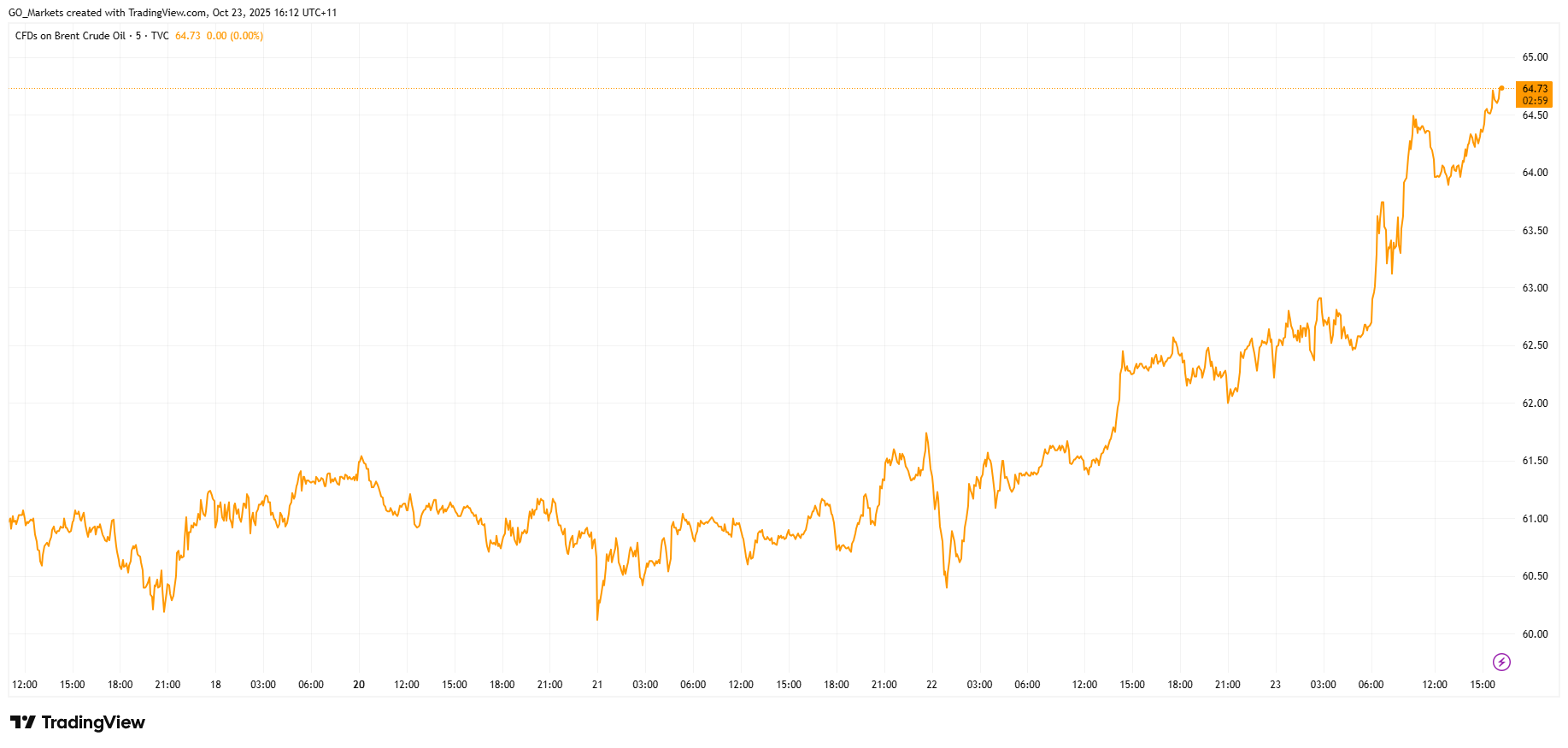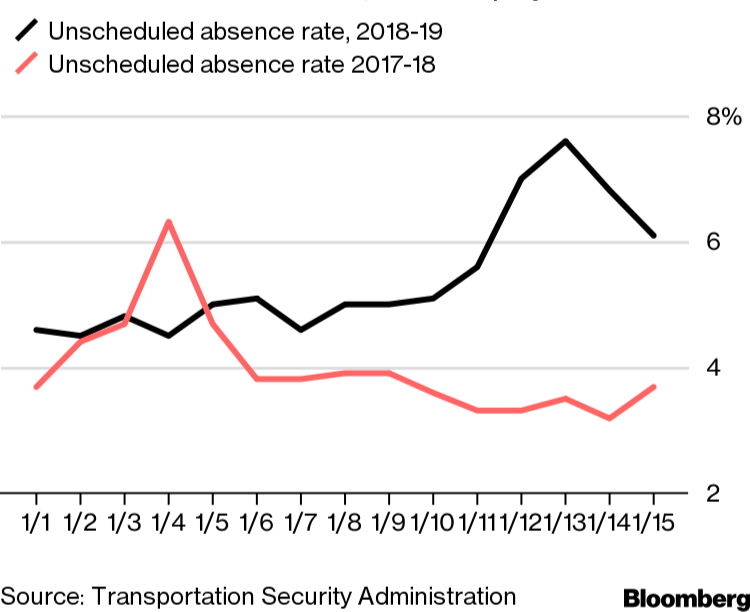市场资讯及洞察

New U.S. Sanctions on Russia as Putin Conducts Nuclear Tests
The U.S. has imposed new sanctions on Russia's two largest oil companies, Rosneft and Lukoil, after planned peace talks between Trump and Putin collapsed on Wednesday.
Oil prices spiked 3% after the announcement, with Brent crude hitting $64 per barrel.

The targeted companies are among the world's largest energy exporters, collectively shipping about three million barrels of oil daily and accounting for nearly half of Russian production.
The sanctions build on recent European measures, as the UK targeted the same companies last week and the EU approved its own sanctions package on Wednesday.
In a show of force coinciding with the new sanctions, Putin supervised strategic nuclear exercises on Wednesday involving intercontinental ballistic missile launches from land and submarine platforms.
While the Kremlin emphasised these were routine drills, the highly coincidental timing is notable.
For markets, the key question now is whether secondary sanctions will follow, and if Trump’s enforcement remains strict. Traders will watch closely for any TACO signals that see Trump ease pressure in an attempt to restart negotiations.
Historic PM Wasting No Time on Celebrations
Sanae Takaichi made history this week as Japan's first female Prime Minister. The 64-year-old conservative leader, dubbed the "Iron Lady,” is already rolling out an aggressive policy agenda that could reshape Japan's economic and geopolitical position.
Her first major move is an economic stimulus package expected to exceed US $92 billion. The package includes abolishing the provisional gasoline tax and raising the tax-free income threshold from ¥1.03 million ($6,800), moves designed to put more money in consumers' pockets and battle inflation.

Her next move will come when Trump arrives in Tokyo next week, as the Japanese government is finalising a purchase package including Ford F-150 pickup trucks, US soybeans, and liquefied natural gas as sweeteners for trade talks.
Takaichi has campaigned on being a champion for expansionary fiscal policy, monetary easing, and heavy government investment in strategic sectors, including AI, semiconductors, biotechnology, and defence.
Critical Workers to Miss First Paycheck Due to Shutdown
The U.S. government shutdown is on the verge of creating a crisis for aviation safety, with 60,000 workers set to miss their first full paycheck this week.
These essential workers, who earn an average of $40,000 annually, already saw shortened paychecks last week. By Thursday, many will receive pay stubs showing zero compensation for the coming period, forcing impossible choices between basic necessities and reporting to work.
During the last extended shutdown, TSA sick-call rates tripled by Day 31, causing major delays at checkpoints and reduced air traffic in major hubs like New York — disruptions which are directly attributed to pressuring the end of the previous shutdown.

The National Air Traffic Controllers Association warns that similar pressures are building, with many workers soon to be facing a decision between attending their shift or putting food on the table.


Market action and underline breath of the last two and half weeks has been extreme and rather eye opening. The S&P 500 has made 38 record all time highs in 2024 so far, however since its most recent peak on July 16 it has traded lower ever since. Now we need to put that into perspective, the pullback since its July high is 4.75 percent to date.
The pullback that we saw in April was 5.7 per cent, the rally at the end of the April pullback was 14.1 per cent to that July 16 high. And overall the S&P 500 is still up 6.6 per cent year to date. But what's really catching our attention is that the pullback in the second half of July looks very much like the pullback that started in July 2023.
If we compare the SNP's year to date performance in 2023 to what we have seen today in 2024 the correlation is surprisingly tight. Have a look at this chart. Yes, the path of the market in the first quarter of 2023 was different to what happened this year but by the end of March (2023 and 2024) the S&P was up a similar amount on a year to date basis.
What we can then see is that from the start of the second quarter through to mid-July that correlation is really tight. So the question we're now asking is are we going to experience déjà vu? The pullback that began in late July 2023 went all the way through to late October 2023 Started slightly lighter than what we've seen this year.
But as the price action shows if we follow what happened last year we could be in for a couple of months of high volatility and the Bulls quickly reassessing their current trajectory. It's going to be interesting because unlike in 2023 where the issues came for monetary policy and the prospect of rate rises or cuts. 2024 has an external factor we only experience every four years and that's a U.S. presidential election. And what might be a trigger point for the bottom of the market if we are about to experience a multi month pullback would be the November 5 election.
Second to that is that all things being equal a rate cut or cuts will have happened by the end of October something that didn't happen in 2023. What's hard to equate is the impact one or more cuts will have on indices in particular as according to the market pricing it's already factored in. It's why the current pullback although close to 2023 the deja vu we are experiencing right now is just that deja vu and not something to be factored into your thinking.
What’s going on in FX? What we are watching very closely on a monetary policy and FX perspective is this coming Wednesday's CPI read in Australia. Over the last 2 1/2 weeks the AUD has been savaged.
So much so that several traders have exited their bullish positions in the Aussie. It's not hard to see why with the AUD/USD losing some two cents in this. Yes this is down to USD strength on the back of a change in the democratic candidate,risk increases in markets, and signs of economic reactivity in the world's largest economy.
But it's not only the AUD/USD but it's saying movements of this kind of magnitude news over the last week and a half of intervention by the Bank of Japan has seen the JPY recuperate some of the losses experienced this year. Again using the Aussie dollar as an example AUD/JPY moved from a high of ¥107.56 to as low as ¥100.5 inside 10 days. This all suggests that at the moment FX is probably ignoring fundamentals and is being caught up in short term external factors.
It is why this coming Wednesday's CPI numbers could be a real turning point in the trading of FX of the last few weeks. Because it should sharpen traders' minds back to the fundamentals. As this chart shows, the expectation of a rate rise on August 6 has been as high as 27 percent in fact at one point in the last two months it's been as high as 46 per cent.
This in our opinion has been fully factored out of FX trading in the Aussie over the last couple of weeks. Thus, if Australia’s trimmed mean inflation rate comes in anywhere north of 3.9 per cent year on year. This chart should rapidly change and be pricing in the probability of a rate hike as high as 80per cent for the August 6 meeting.
What this means for FX is that the current sell off in the AUD is probably overdone and will rapidly unwind itself. Those bulls that have been shaken out over the last week and 1/2 will more than likely reinstate positions. Crosses that have been savaged are also likely to face a rapid snapback because from what is currently presented in the data suggests the Aussie is more fairly valued where it was two weeks ago rather than where it is now.
The caveat If however Australia is trimming inflation rate comes in at or below 3.9 per cent. Then the current pricing of the Aussie is probably fair, and the reaction is likely to be negative. All pricing this year in the local currency has been on the premise of an improving China which is yet to materialise and the divergence that's happening at the RBA.
If inflation indeed is showing signs of finally declining in Australia then there will be a reaction to the downside because the probability of a rate increase in 2024 will drop back to almost 0, as there will be no data strong enough to convince the RBA to raise rates again is there a hesitant hawk something we discussed 4 weeks ago. We will do a full report on the CPI next week and how to trade it leading into the August 6 RBA meeting.


The horrible events that we're currently seeing in the Middle East can sometimes create an unwanted attraction for traders. Chasing short, sharp swings in things like oil and other commodities of this ilk, might appear attractive for the here and now upside opportunity but be aware geopolitical trading always ends in bad outcomes. This is why we want to point out in this article the avenues you could consider with geopolitical risk in the Middle East.
These include impacts on things such as shipping, auto industries, consumer and retail goods, soft commodities etc. While we highlight this is because it gives you more time and a better fundamental understanding of the structural impacts that could positively and negatively impact these industries. Trying to predict actions and reactions of geopolitical outcomes will always lead to bad trades.
Backgrounding Biggest playbook from a trade perspective in the Middle East is what happens to the Red Sea And by extension the Suez Canal. The impact the Suez Canal has on global supply is astounding. 30% of global container traffic travels through this straight and into the disputed area of the Red Sea. It is an essential artillery for international trade, particularly economic centres of Europe, Asia and North America.
Possible disruptions to the supply chain could lead to widespread logistical challenges particularly those that rely on the minute delivery time systems. We have already seen examples of what may happen now at the start of the year. In late January early February the Red Sea was the centre of attacks by Houthi rebels on cargo ships and tankers, creating major disruptions in global maritime trade.
The resultant behaviour or global logistics was to send hundreds of vessels around the significantly longer Cape of Good Hope route southern, adding approximately 6,500 kilometres to their journeys. This detour led to inflated transit times, freight costs, and caused supply chain bottlenecks leading to a re-inflation issue worldwide. Before we play that out in the current environment, inflated transit times heightened freight costs supply chain bottlenecks coupled with interest rate cuts and central banks trying to reignite economies - could we be looking at interest rate hikes to offset this in 2025?
Does it also lead to higher levels of spoilage waste and poor products that demand lower pricing despite lower goods? These are all questions that need to be considered and questions that give traders time to position a manoeuvre in What is normally a rapidly changing trading environment. Here’s a detailed look at how this crisis could affect global supply chains, shipping costs, and inflationary pressures.
Automotive Industry: The global auto industry would be among the hardest hit by a Red Sea crisis. European auto manufacturers, which rely heavily on parts sourced from Asia, announced temporary production halts at the start of the year when the Red Sea was closed. The European market is particularly dependent on Chinese exports of new-energy vehicles (NEVs), which are primarily shipped by sea, and the extended shipping times could have serious consequences for auto production schedules, vehicle availability, and pricing.
Further stressing the resilience of the automotive supply chain, especially if these delays come on top of existing disruptions in global semiconductor supply — a key component for both conventional and electric vehicles. Suppliers, particularly those with significant revenue exposure from China to Europe and the U.S., will feel the impact of extended lead times and will lead to share price impacts. Consumer Goods Retailers both in Europe and Asia rely heavily on sea freight for inventory replenishment.
Shipping delays that could disrupt product availability, particularly for time-sensitive items such as seasonal goods are plays traders need to watch. While some large retailers have and will hedge against freight rate increases by locking in shipping rates through the second half of 2024, they are not entirely insulated from further disruptions. If supply chain bottlenecks worsen, they may face difficulties in securing stock, especially for goods sourced from Asia, potentially leading to stock shortages and rising consumer prices in the European and Mediterranean markets.
Manufacturing and Industrial Supply Chains: The broader manufacturing sector, including electronics and heavy machinery, is also at risk. Extended shipping times will likely affect lead times for raw materials, intermediate goods, and finished products which in turn leads to slowing production cycles. Again, if we use the impacts from February as a baseline example the rerouting of vessels around the Cape of Good Hope saw an increase in transit times by about 30%, translating to a 9% reduction in global shipping capacity.
The impacts this time would be of a similar nature. The unknown is the length of time the delays and closures will be in place. Along with the conflict drags on the more bottlenecks it will create.
The reduction in capacity creates ripple effects across various industries, as businesses are forced to manage longer delivery times, increased uncertainty, and higher costs for shipping essential goods. Considering the likes of France, Germany and Italy are major high-end manufacturing players. These the markets traders should be looking at closely along with the impacts trade might have on the currency.
Again using February as the example, the EUR fluctuated rapidly during this time as data points released in March through to June showed these three nations and the periphery struggled economically. A similar issue is likely this time around as well. The final conclusion from the horrible events that we are seeing in the Middle East is again beware of geopolitical trade.
We cannot emphasise this enough chasing risk both up and down the momentum trade will lead to undue risk taking and probable loss. The evergreen lesson from these kinds of events is not to look at the ‘now’ but look at what happened previously when these have occurred as the probable outcomes this time around. History never repeats itself, but it does follow a similar pattern.


2024 continues to be an interesting year for FX. Even more now that the starters gun has been fired with the European Central Bank (ECB) and Bank of Canada as well as the likes of the Riksbank and SNB all starting to their respective cash rates from COVID peaks. This brings us to the next stage – who is next, who is going the other way and where does that leave pairs and crosses?
Well let's start with the biggest gorilla in the pack The US Federal Reserve. We have to start here because the US dollar at the moment is in an interesting conundrum: it has dovish to neutral leaning central policy which in theory overtime should put a downward trajectory in the dollar, but has been holding or moving to the upside against majors as its investment outlook rights and overall attractiveness outweighs the negative bias of a dovish position. The question also remains how Darvish is the outlook for rate cuts from the US Federal Reserve?
Markets have a bias for the Fed to start rate cuts in September with 18 basis points. That equates to about a 68% to 71% chance. May's softer core PCE inflation data that dropped last week supports the likelihood of cuts due to slowing inflation.
Core PCE inflation came in at 0.08% month on month, well below the expected 0.15%. The faster decline was due to lesser-known components, such as non-profit prices and imputed financial services which have now slid for three consecutive months (something we would like to see in Australia) should encourage Fed officials. But the market has been hesitant to react to the PCE why?
Clearly the Fed’s language and actions of late suggest it needs more evidence of easing inflation is sustained. This could be achieved with another favourable read for the June numbers which are due out at the end of this month. We also note that revisions to April’s core PCE were modest (were revised up), and May’s weaker data might indicate a positive trend in Q2.
Remember this is the Fed core measure of inflation and needs it to be at or around 2%. Dollar Basket Yet once again we come back to the USD – its lower compared to pre-PCE trading but not by a margin that gives confidence the Fed is going to cut rates in the coming months. Which suggests we need to break out the pairs and look more directly at actions.
EUR/USD If you look at EUR/USD, the biggest player in the DXY, the easing bias from the Fed is there. Not only that since the ECB cut rates last month there has been a growing belief the Board will hold off to see the reactions across the zone before acting again. Inflation in the likes of Germany, France and Italy are so varied it hard to get a proper read on the overall composition of the eurozone which is going to make it very hard for the ECB and its board's decision making.
Explains why the initial decrease in the euro has subsided. We also can't write off the elections that are going on inside France right now. The rise of the far right nationalistic protectionism parties clearly also is a threat to the eurozone and therefore the euro itself.
However with that in mind if you look at the central bank differentials between the ECB and the US Federal Reserve. It is clear that there is more of a dovish bias from the Fed (as they should be) and it's more likely the Fed is going to move next rather than the ECB. Listening to Fed talkers like Governor Cook who expects cuts soon.
Then there are the doves like San Francisco Fed President Mary Daly that are razer focused on unemployment. She described the risk that “future labour market slowing could translate into higher unemployment, as firms need to adjust not just vacancies but actual jobs.” She stated that past tolerance of high unemployment to curb inflation like that in the 1970 and 1980 was not tolerable – suggesting that inflation is not the only trigger there. Governor Cook downplayed recent strong job growth, citing overstated payroll gains and a slower true pace of job gains.
Weak labour data this Friday (non-farm payrolls) could signal rate cuts at the July FOMC meeting. On the NPF the consensus is for a slower 155,000 increase for the month of June. The unemployment rate is projected to stay at 4.0%, and average hourly earnings should rise by 0.4% month on month.
The Fed's June meeting minutes this week will likely show higher 2024 rate cut projections, with officials needing more data to be confident in sustained inflation reduction. In short, USD data is forecasted to be bearish. So it’s about choosing your pairs wisely and clearly things like EUR, GBP, CAD etc. are difficult to deal with currently as each is facing a bearish issue of their own.
Thus let us finish on a differential that is clear – the RBA versus the Fed and the Bank of Japan. AUD/USD Although AUD/USD hasn’t completely broken out of its 0.661 to 0.669 range. The slow uptrend momentum is building.
The test as we described last week is the July 31 CPI print. The minutes from the last RBA meeting were telling – there are only two options on the table, hold or hike and the argument for a hike was well made and without the May monthly inflation read. A print above 3.9% August 6 is basically a lock putting the RBA out of sync with the rest of the G10.
The differential here is glaring and one of the most bullish signals for the AUD. We watch the AUD/USD for signals that uptrend is on. Which brings us to the final cross to discuss.
AUD/JPY The trend is clear and the different responses between the BoJ and the RBA couldn’t be starker. The BoJ has lost control of its currency and is unable to provide stability. The pressure it's experiencing is real and with next to no inflation Japan is facing a difficult situation of dealing with capital outflows while needing to be accommodative.
Count that with the RBA that has the highest cash rate in 12 years, highly attractive yields and. The possibility of further increases – cash inflows are glaring. The cross has been capping out at Y107.5 but once again July 31 is key – inflation signalling rate hikes and AUD/JPY will be chasing Y108 and beyond.


If you look at equity markets in particular, you'd think everything smelled of roses. For the 47th time this calendar year US indices have made record all-time highs and 46 times at record closing highs. Earning season is underway and so far, it is doing what it always does, which is beating the Street 75 percent of the time.
Banking, Tech and industrials are the standouts. And even when you look at the 493 non magnificent 7 stocks on the S&P 500 the gap between the seven and the rest is finally starting to close up. So all is well at least that's how it appears.
However over the next 20 days the risks that are facing global markets cannot be understated. First and foremost is the US presidential election. As we point out in our US 2024 election specials, the margin between Trump and Harris has never been closer.
In fact, most probability markets now have Trump ahead. Predictit for example, Trump leads by three points and on RealClearPolitics it's even larger sitting at 10.8 points. Most of the key states or swing states are statistical dead heat but on average Trump is now ahead by 0.2 at 47.7 to 47.5.
Whichever way you look at it, whoever wins on Election Day, it will lead to disputes and the other side is unlikely to accept the result. The political upheaval will filter through into markets, and we need to be ready for that. What has also been lost in geopolitics and the incredible run in equities is movements in the bond market and the risks around US inflation.
And it is this that we need to take a closer look at. Trends and Key Drivers in US Inflation Blink and you will have missed it, the back end of the USU curve is back above 4%. This is down to several risk factors, The US presidential election being one, employment being another, and then the big one inflation rearing its head in September.
There was an unexpectedly strong rise in CPI inflation for September. So is there some going on here or is it just a false flag? First things first - Core PCE inflation continues to trend at a consistent pace of approximately 2 per cent on an annualised basis.
This suggests that inflationary pressures, while present in some sectors, remain largely in check but risks remain. So what are the keys here? Key Factors on the Inflation Outlook: 1.
Core CPI Outperformance and PCE Expectations: September's core CPI surprised with a 0.31per cent month-on-month (MoM) increase, surpassing consensus forecast of 0.25 per cent. While this unexpected rise is noteworthy, the details of the PPI (Producer Price Index) data suggest a more moderate increase in core PCE inflation, estimated at 0.21per cent MoM for the same period. The issues in the inflation figures however remain in components such as shelter and insurance, which had been driving much of the previous increases, with weather events and housing price volatility expect inflation fluctuations here to persist in the near term.
The upward surprises in the headline CPI data were concentrated in volatile categories like apparel and airfares. Airfares, for instance, rose by approximately 3 per cent MoM on a seasonally adjusted basis. 2. Wage Growth and Labor Market Dynamics: The Atlanta Fed’s wage tracker indicated that wages picked up in September, with the unsmoothed year-on-year (YoY) measure reaching 4.9 per cent, up from 4.7 per cent in August.
Additionally, the 3-month smoothed measure and the overall weighted average both rose to 4.7 per cent, compared to 4.6 per cent in the previous month. Whichever measure you want to use, real wages in the US are growing at about 2.5 per cent. While this wage growth exceeds the rate typically consistent with a 2 percent inflation target (in the absence of significant productivity gains), it remains only modestly stronger and isn't a concern, yet.
It’s worth noting that wage growth may take longer to cool off, particularly given seasonal patterns in early 2024 and the effects of recent labour strikes in sectors like port operations and aircraft manufacturing, both of which have underscored the potential for more persistent wage inflation. Interestingly, the Atlanta Fed wage data revealed a sharp deceleration in wage growth for job switchers compared to job stayers. Normally, job switchers see higher wage increases, but over the past few months, the growth rates for both groups have converged.
This shift may signal weaker demand for labour and could be a key indicator of wage trends in the coming months. However, wages for current employees may lag behind, requiring time to adjust downward, much like how rental prices for new leases often move ahead of existing rents in shelter inflation. This dynamic suggests that wage pressures might remain elevated for a time, particularly if companies raise wages for existing employees to catch up with the now-slowing wage increases for new hires.
The ongoing wage growth for current employees could also keep hiring demand subdued, as firms may focus on managing costs rather than expanding their workforce only time will tell here. 3. Potential Impact of Hurricanes Helene and Milton: The inflationary impact from Hurricanes Helene and Milton are yet to be factored into most forecasts and thus it is important to acknowledge the potential for volatility in certain inflation components. Historically, hurricanes have primarily affected gas prices by disrupting supply chains.
However, there has been only minimal upward pressure on retail gas prices so far. Demand led cost in infrastructure and construction supplies also tend to increase post hurricanes as the clean-up and rebuild takes precedence. Another major CPI component that has historically shown sensitivity to hurricane-related disruptions is "lodging away from home." For example, in the aftermath of Hurricane Katrina in 2005, lodging prices initially dropped before rebounding the following month.
It remains unclear whether the recent hurricanes will affect hotel or recreational service prices in Florida, which were among the areas impacted. September CPI already showed weaker-than-expected data for lodging, and with discretionary spending on services potentially declining, this component could face further downside risks. However, if there is an unusually sharp drop in lodging prices for October, any hurricane-related distortions might result in a bounce-back in November CPI.
This is why we think the market needs to remain cautious on core PCE inflation. Will it stay modestly higher than the Fed’s 2% target over the near term? It's clearly possible.
Then there is the ongoing volatility in certain sectors and potential risks from external shocks like hurricanes mean inflation forecasts could still see adjustments. All in all we remain vigilant that despite the enthusiasm and bullishness in indices risks are building and traders need to be vigilant.


It's well-known that many discretionary traders struggle with discipline, emotional control, and other psychological hurdles that can impact their decision-making process, particularly when it comes to entering and exiting trades. One of the widely recognized benefits of automated trading models, however, is the belief that these psychological barriers are removed or significantly reduced. Automation, after all, is designed to eliminate human emotion from trading decisions.
However, the assumption that psychological challenges vanish with automated trading is far from reality. As you delve into the exciting world of creating and trading “Expert Advisors” (EAs), it is crucial to understand that psychological challenges still exist, albeit in a different form. You must be prepared to face various mindset issues during the EA development and trading process.
This article outlines and aims to inform on nine key potential psychological challenges traders might encounter when working with EAs and offers guidance on how to navigate them effectively. Use this checklist to develop an awareness of potential issues and take meaningful action to enhance your trading performance. 1. Over-Optimization and Curve Fitting One of the most common challenges traders face when developing EAs is the temptation to over-optimize their algorithms.
This refers to tweaking the EA to perform perfectly in historical backtests but at the expense of real-world effectiveness. While an over-optimized EA may show stellar performance on past data, it often falters when faced with live market conditions, leading to frustration and self-doubt. To mitigate this, it is vital to stay focused on each stage of the EA creation process and avoid the trap of endless refinement.
Always keep in mind two fundamental principles: The purpose of an EA is to reliably generate profits. Once this is achieved, the next step is simply scaling the strategy. The purpose of backtesting is not just to validate that the settings work but to justify moving to a forward test. 2.
Fear of Loss Fear and anxiety can emerge when transitioning from testing to live trading, especially when real money is involved. Traders may worry about losing their capital or encountering a significant drawdown that tests their emotional resilience. This fear can act as a barrier, preventing traders from taking their EAs live or increasing trade sizes, even when results suggest it is the right time to scale up.
Developing confidence in your EA through thorough backtesting and forward testing is key to overcoming this fear. 3. Lack of Control Another psychological hurdle is the feeling of losing control when relying on an automated system. With discretionary trading, traders are actively involved in every decision, whereas, with an EA, the algorithm executes trades without human intervention.
This can lead to feelings of helplessness, especially if the EA doesn’t perform as expected. Watching trades unfold on your account without direct involvement can be unnerving, tempting traders to interfere prematurely. Resisting the urge to manually override the EA is crucial.
Trust the system you’ve created, as long as it is backed by solid logic and testing. 4. Confirmation Bias Traders may fall into the trap of confirmation bias, where they only acknowledge the positive aspects of their EA’s performance while overlooking warning signs or evidence of flaws. This bias can be dangerous, as it blinds traders to potential weaknesses that may lead to significant losses over time.
Creating a set of objective performance measures, such as maximum drawdowns and key profit metrics, can help maintain a clear and rational perspective on the EA’s success. Emotional attachment to an EA that has taken considerable effort to build can cloud judgment, so it’s important to remain objective, especially when difficult decisions arise. 5. Overconfidence Success with one or more EAs can lead to overconfidence, which is a major psychological pitfall.
Traders may begin to overlook necessary refinements, substitutions, or additional testing. Early successes might lead them to believe they can expedite the process of moving an EA to live trading and scaling it, without taking the time to gather sufficient data from a large enough sample of trades. Patience is essential when transitioning to live trading.
Ensure that a critical mass of data is available before making decisions about scaling or altering your approach. 6. Impatience Many traders expect immediate results from their EAs, which can lead to impatience. This impatience often results in premature modifications or abandonment of strategies that could have been profitable over a longer time horizon.
There are no shortcuts in trading. Allow time for your EA to demonstrate its potential over a defined period, rather than making snap judgments based on short-term performance. Regularly comparing live results to backtests over a reasonable timeframe can provide the necessary context to assess whether an EA is working as intended. 7.
Adaptability Market conditions change, and EAs that perform well in one environment may struggle in another. The psychological challenge here lies in being open to the necessity of adaptation. Some traders may hesitate to make changes or replace an EA, fearing the effort it took to develop the original model.
Consistent monitoring and having clear criteria for when adjustments are needed are vital to long-term success. Embrace the process of refinement, knowing that adaptability is essential for keeping your EA portfolio profitable in different market conditions. 8. Social Comparison Comparing your EA’s performance to others can lead to feelings of inadequacy, envy, or frustration, especially if you perceive that your system isn’t performing as well as someone else’s.
Social comparison is common among traders, but it can lead to unnecessary emotional strain unless checked. It’s important to remember that traders are often more vocal about their successes than their losses. Maintain a focus on your own progress and the unique journey of developing a system that works for you. 9.
Emotional Resilience The ability to stay emotionally resilient during drawdowns or periods of underperformance is critical. Fear, anger, frustration, and impatience can cloud your judgment and negatively impact decision-making, including premature withdrawal of an EA. With any strategy there will be periods of under and over performance.
Accepting this is critical for good long-term decision making. Obviously, time is a great “calmer” in terms of developing not only confidence but also this acceptance. Anecdotally, new automated trades are most at risk until there is a “record of achievement”.
This is one of the key reasons why trading any new EA at minimum volume as you discover how it performs under live market conditions is vital. In Summary Addressing these psychological challenges is essential for success in the world of automated trading. Taking these points on board and stepping back to review where you are as many of these may creep in insidiously over time would seem prudent.
Practical steps you can take may include: Developing a deep understanding of your EA’s logic and parameters, so you trust the system you’ve built. Setting clear performance expectations and avoiding comparisons with others. Developing self-awareness and emotional regulation to stay calm during turbulent times.
Regularly reviewing and updating their trading strategy on which the EA is based, including sighting charts of trades taken and refinement of risk management strategies are always worthwhile. Consistent monitoring is vital. Taking breaks to avoid burnout and maintaining a healthy work-life balance.
Trading EAs do create an interesting set of challenges but as stated previously, awareness that these challenges may exist is the first step to be able to take meaningful action and continue the work on yourself. Whether you ae a discretionary or automated trader, this rule is unquestionable and always the start point of long term improvement in trading decision making. If you are interested in the GO Markets automated trading platform and strategy tester, and the education we can provide relating to this topic, please feel free to connect at [email protected] at any time.


热门话题
近期,美股市场显现出分化格局,科技股承压明显,而蓝筹股表现相对稳健。这背后反映了市场情绪的波动与宏观经济的不确定性,以下为具体情况:

截至2025年1月28日,标普500指数收于599.37美元,较前一交易日下跌1.39%;纳斯达克100指数下挫2.93%,收于514.21美元;而道琼斯工业平均指数逆势上涨0.68%,收于447.12美元。科技股的表现尤其疲软,其中英伟达大跌17%,市值损失创纪录的5890亿美元,据福布斯网站显示,该公司首席执行官、最大个人股东黄仁勋净资产在收盘时缩水了208亿美元,从1244亿美元跌至1037亿美元,从福布斯实时亿万富翁排行榜的第10位跌至第17位。

甲骨文(ORCL.N)下跌14%,董事长拉里·埃里森净资产缩水276亿美元,从全球富豪榜第三跌至第五。与此同时,苹果公司逆势上涨3.18%,重新夺回全球市值第一的宝座,展现出强劲的基本面支撑。

市场情绪方面,恐慌指数VIX上涨20.54%,达到17.90,市场避险情绪升温。一方面,美联储货币政策调整、通胀数据波动以及经济增长预期的不确定性,尽管黄金价格短期内保持观望,2025年黄金依旧是投资者关注的焦点。另一方面DeepSeek引发的更广泛的市场下跌,迫使投资者在市场中进行套现。展望未来,美股市场可能持续高波动性。投资者需密切关注关键经济数据,如今晨发布的美联储利率决议,午时将要发布的澳大利亚第四季度CPI。此外,科技股的估值调整是否持续以及蓝筹股的稳定表现,将对市场走向产生重要影响。 当前市场环境下,建议投资者合理分散投资组合,关注基本面稳健的优质资产,同时适当配置避险品种如黄金和债券。复杂的市场环境中,保持理性、稳健决策是实现长期收益的关键。免责声明:GO Markets 分析师或外部发言人提供的信息基于其独立分析或个人经验。所表达的观点或交易风格仅代表其个人;并不代表 GO Markets 的观点或立场。联系方式:墨尔本 03 8658 0603悉尼 02 9188 0418中国地区(中文) 400 120 8537中国地区(英文) +248 4 671 903作者:Sylvia Qin | GO Markets 悉尼中文部

